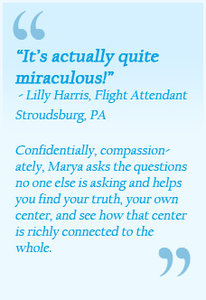This Sacred Life: The Yamas

Whether you find an event blessed or not, there is inherently some blessing inside both a child’s smile and a criminal’s cover-up.
Changing our eyes is more potent than changing events, for how we see a thing, a moment, a chance occurrence, will ultimately color its effects. Our beliefs hold the key to making our lives exceptional, and that begins with looking at not only what we are seeing, but how we are seeing, and what we are seeing with.
Are our eyes gazing with the expectation of woe and worry, or have we softened the eyes and trained them to loving kindness?
The universe itself, I believe, is waiting for us to leap up from the ground laughing at the conditions we call woeful. Our feeling for the sacred comes from a preference for seeing the good inside even the most horrible circumstances.
When the tears have cleansed our eyes and softened the gaze, when we make room for the sacred in our hearts, our lives change.
The problem arises when we don’t see the sacred for ourselves; we may need a mentor, family member, or friend, an experience in nature, a book, or a work of art, to point out that even the thorniest bushes have the most fragrant and beautiful roses.
We may need a daily practice that reeducates the brain, body, and especially the eyes to see the sacred right in front of us, what is beautiful and exhilarating in being human.
Before they set down in writing the way Yoga could rejuvenate the Soul, Patanjali and the ancestral yogis had been watching what happens when people take up a sacred practice that includes intention, breathwork, and meditation for many years.
They witnessed that those who aimed their minds toward Ahimsa – kindness and consideration – infused their bodies and relationships with the quality of sweetness. The more pleasant and friendly they were, the more their very presence engendered kindness in others. Everyone was happier.
So, somewhere between 200 BCE and 200 AD, Patanjali wrote the Sutras – which means “stitches.” Weaving together what they were finding in 196 brief aphorisms for living a wholesome life, they described the first Yama, or ethical principle for social harmony, as Ahimsa, non-violence.
The more energy we devote to kindness, the more truth we will discover, so the second Yama, Satya, is specifically not-lying. Truth-telling requires us to be true to the real situation, our real feelings, and the higher mind’s intention. When we always speak the truth, then everything we say will be truthful.
There is a fiery story from the beloved Indian epic, the Ramayana, on the theme of Satya. The monkey god Hanuman, Prince Rama’s servant, sets out to look for Sita, his master’s wife. He travels to Sri Lanka where she is being held prisoner. Toward the end of his time there, he is caught by the evil captors and his tail is set on fire!
When Sita sees Hanuman’s pain from his burning tail, she calls out: “Let the fire cool!” Hanuman’s suffering immediately stops.
He shouts, “What happened? Why doesn’t the fire burn me anymore?”
Because Sita always spoke the truth, her words had great power and could extinguish the flames and pain. For those who are always truthful, speech and action fly like two birds courting and blending in the sky.
Yet it is not always desirable to speak the truth if it could harm someone unnecessarily. We consider,what we say, how we say it, and how it may affect others. If it will harm another, be creative. Come up with another way to speak your truth and uplift the situation. In the Mahabharata, the Indian epic, says Krisna, “Speak the truth which is pleasant. Do not speak unpleasant truths. Do not lie, even if the lies are pleasing to the ear. That is the eternal law, the dharma.”
With the union of kindness and truth, the third Yama, Asteya comes into play. Steya means to “steal.” Asteya is the opposite – take nothing that does not belong to us. A person established in non-stealing will receive all the jewels of this world, but this person often is not terribly interested in material wealth. They will have access to wealth, but most importantly, they will have the most valuable things in life.
The more we recognize the meaning of the search for truth, the easier it becomes to relinquish what is temporary. We don’t become distracted as easily, and we develop a non-grasping attitude, Aparigraha, the fourth Yama.
Yoga builds strength but requires your stamina, your return again and again to the breath, to balance, to separating out what is real, Vidya, from what is unreal, Avidya. What is true from what is not you.
With the fifth Yama, Brahmacarya, we ask ourselves to move toward the essential, the Vidya. Composed of the root car, which means “to move,” and the word brahma, which means one essential truth, we achieve a moral compass, even as we make mistakes, fall, fail, get up, fall again before rising.
Brahmacarya can be interpreted as abstinence from sexual activity, but that is not quite the whole of it. This Yama encourages us to sustain our direction toward the Highest Self, and if sensual pleasure is part of our relationships, we take care to be responsible, respectful and careful of our and others’ Higher Selves, keeping the other Yamas that begin with non-harming and truth-telling.
With the Yamas, the fruits of Yoga practice begin to grow, and we find ourselves not devoid of passion, but more discerning in the choices we make. We can live a life of wonder and clarity because we are gaining the strength and vision to do so.
When we have strength, faith comes. When we have faith, strength can grow. The Yoga Sutras say that the more strength we have, the more energy we have to pursue our goals. This leads us to sraddha, deep trust that things are right on track and we are moving in the direction of our Dharma, in the Hawaiian language, our Kuleana.
We are living a sacred life.
Please visit Marya’s Yoga classes. Go to the Calendar at http://www.maryamann.com/calendar/month-view/
Or Call Kona Coast Yoga & Wellness at 808-345-0050.


